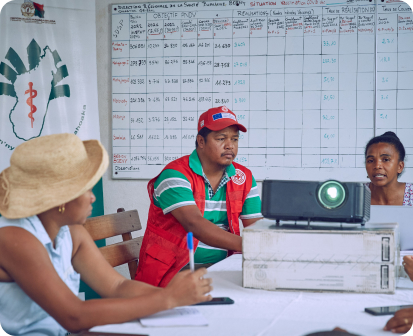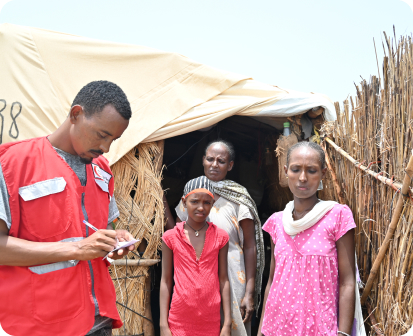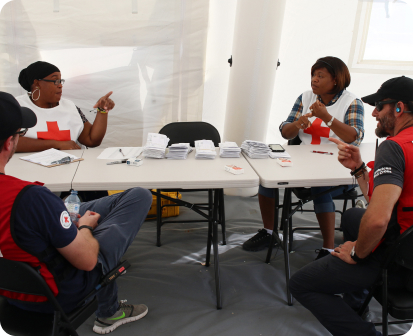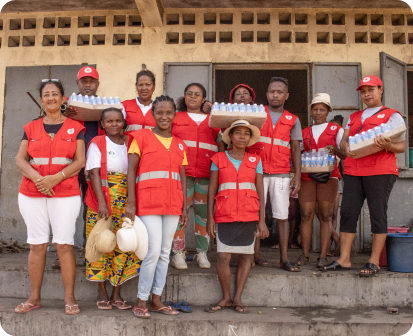The Index
An evidence-based tool for measuring and fostering trust in humanitarian action
Objectives
The Community Trust Index is a practical, evidence-based framework that helps organisations and programmes to understand, monitor and strengthen the trust placed in them by the people they serve. Built around measurable competencies and values, it transforms the complex and often abstract concept of trust into clear signals that leaders can act on. These signals relate to service quality and perceptions of fairness, which are important for communities. The Community Trust Index provides organisations and programmes with the means to:
Measure
Measure community trust and the factors influencing this trust.
Understand
Understand and track trust over time and compare how community trust differs geographically or between different groups of people.
Act
Develop informed actions for fostering community trust in humanitarian action.
The community trust index
Methodology noteTrust is a multidimensional concept. The Trust Index framework applies a structured approach to measure two primary dimensions widely identified in the literature: competencies (technical reliability) and values/ethics (alignment with community beliefs and priorities).
Competencies refer to community perceptions of the organizations or program’s capability, including its ability to provide timely support, understand community needs, ensure accessibility, be open and approachable, and effectively deliver assistance.
Values/Ethics refer to community perceptions of the organization’s, programs or action’s intentions, such as its fairness, inclusiveness of diverse groups, engagement with the community, transparency, and integrity.

Modules
Institutional Trust
The Institutional Module aims to measure community trust in humanitarian institutions and organisations. It focuses on community trust towards the Red Cross/Red Crescent (RCRC) National Societies, and provides adaptable tools for other organisations working at the local level.
Thematic Trust
Early Warning and Anticipation
Delves into trust in forecast and risk information, early warning systems and actors
Climate Action
Explores trust in locally-led adaptation, social protection for climate and more.
Public Health
Focuses on trust in health preparedness and response efforts including vaccines, and therapeutics
Migration and Displacement
Looks at trust in information aid, and support to population on the move.
Analytical Framework
Our Journey
Frequently Asked Questions & Answers
A group of people with a common characteristic or interest living together within a larger society. Not everyone in the community is the same and within and across communities there will be a wide range of needs, capacities, and risks. Therefore, when you see the word ‘community’ in this guide, it refers to all the diverse groups who make up a community, including women, men, boys, and girls, older persons, people with disabilities, different ethnic groups, sexual and gender minorities and marginalized or at-risk groups.
Is “a person’s belief that another person or institution will act consistently with their expectations of positive behaviour”. Trust is driven by a solid social contract, which are rules, obligations, norms that bind the different people together and shape their thoughts, attitudes, and behaviours.
In the RCRC context, the issue of trust was highlighted in a special session at the 2019 RCRC International Conference, where one of the key messages was that trust if often taken for granted, and as RCRC organisations we believe that communities trust us, but there is no clear scientific evidence on trust and what aspects we need to improve to achieve the quality and sustainability of our actions. Based on these recommendations, the IFRC’s CEA unit is creating the Community Trust Index as part of the USAID-BHA project to help understand community trust.
A scientifically tested tool(s) for measuring and fostering community trust in the humanitarian action. The tools include implementation guide, a quantitative survey with standardised set of questions that together measure the level of community trust toward a humanitarian aid organisation such as a Red Cross/Red Crescent Society, a qualitative guide to be adapted to complement the survey results, and more guidelines to move from data to action and foster trust in the National Society level. The Trust Index is not a single tool. It is is an initiative that uses a set of tools (the survey is just one tool) to measure trust and grasp the contextual barriers and enablers of trust.
The Community trust Index overall aim is twofold: 1) research: to obtain evidence-based information on the level and variation of community trust, and barriers and enablers and 2) action: to provide recommendations, and action plans to foster and increase community trust, particularly in the Re Cross/Red Crescent Societies.
The Community Trust Index is an IFRC global project led by National Societies through regional coordination. For the Index to achieve its goals, the global, regional, and national levels must work together in a coordinated manner to share guidance, jointly develop plans for data collection and analysis, and develop evidence-based recommendations and interventions to foster trust. Poor collaboration between the different levels could jeopardize the effectiveness of the project and lead to duplication of effort.





